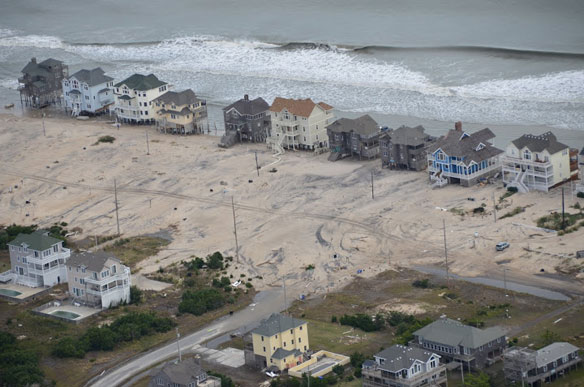
Aerial pictures of North Carolina’s coast, after superstorm Sandy devastated the area. Photo courtesy of: © Program for the Study of Developed Shorelines (PSDS) / WCU
Excerpts;
North Carolinians driving to the coast now will see large numbers of dead trees on the lower most coastal plain, a reflection of rising sea level. For example, along Highway 64 on the way to Nag’s Head and along Highway 17 down east and south of Wilmington, stark trees without leaves or needles abound. The numbers of dead trees have increased greatly over the last several years, likely caused by a rising sea level pushing up the lighter fresh water that drowns the roots of these trees. At the same time, spring tide coastal flooding is steadily worsening in various coastal cities, such as Annapolis, Norfolk, Charleston, and Miami — an indication of a slowly rising sea level.
In the U.S., North Carolina stands alone in doing basically nothing of consequence in sea level rise planning and even discourages state employees from mentioning global climate change. New York, New Jersey, Maryland, and Virginia are planning, as well as taking baby steps, in an effort to start responding to sea level rise. These states recognize the huge implications of the rising sea on developed shorelines.
Instead, the response of North Carolina has been to hold the shoreline in place at great cost and even encourage further development…
Read Full Article, By Dr. Orrin H. Pilkey; Carteret County News-Times (06-15-2016)
North Carolina Sea Level: No more head-in-the-sand? Yale Climate Connections (04-09-2016)
Nature Confronts Politics in North Carolina; (05-26-2015)
As local politicians underestimate rising sea levels, coastal communities are coming up with their own plans…
“North Carolina: The Beaches Are Moving,” A Video featuring Orrin Pilkey, PhD
World famous coastal geologist Orrin H. Pilkey takes us to the beach and explains why erosion has become a problem…
Sea Level Rise Accelerating In U.S. Atlantic Coast, USGS (06-25-2012)
North Carolina Should Move With Nature on Coast, News Observer (01-05-2015)
Sea level rise threatens U.S. historic sites, CBS News (04-13-2016)
Many of the most threatened sites in North America lie along the East Coast between Cape Hatteras, North Carolina, and southern Maine, where the rate of sea level rise is among the fastest in the world…
“Retreat from a Rising Sea,” A book by Orrin H. Pilkey, Linda Pilkey-Jarvis, and Keith C. Pilkey








